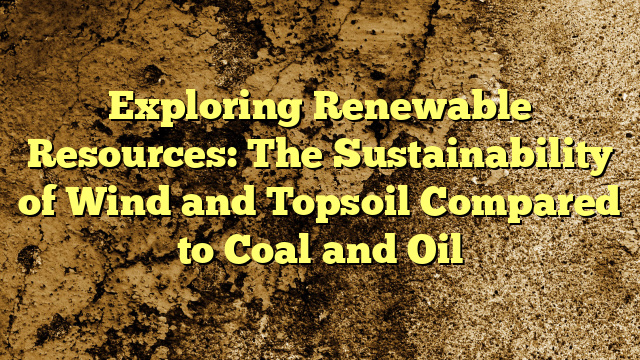Exploring Renewable Resources: The Sustainability of Wind and Topsoil Compared to Coal and Oil
Exploring Renewable Resources: The Sustainability of Wind and Topsoil Compared to Coal and Oil
In the quest for sustainable energy and environmental conservation, the comparison between renewable resources like wind and topsoil against non-renewable ones such as coal and oil is increasingly pertinent. This article delves into the sustainability aspects of these resources, highlighting their impacts, benefits, and challenges.
Understanding Renewable vs. Non-Renewable Resources
Before comparing specific resources, it’s crucial to understand the fundamental differences between renewable and non-renewable resources. Renewable resources are those that can be replenished naturally over short periods, while non-renewable resources are finite and deplete over time.
Renewable Resources
- Wind: Harnesses the power of air flow to generate electricity.
- Topsoil: Supports plant growth, which is vital for food production and carbon sequestration.
Non-Renewable Resources
- Coal: A fossil fuel used primarily for electricity generation and industrial processes.
- Oil: Another fossil fuel used in transportation, heating, and as a base for numerous products.
Comparing Sustainability Aspects
The sustainability of these resources can be evaluated based on various criteria, including environmental impact, availability, and economic viability.
Environmental Impact
| Resource | Impact |
|---|---|
| Wind | Minimal emissions, reduces greenhouse gas emissions |
| Topsoil | Supports biodiversity, essential for carbon sequestration |
| Coal | High greenhouse gas emissions, leads to air and water pollution |
| Oil | Significant contributor to greenhouse gases, risk of spills and environmental damage |
Availability and Renewability
Wind and topsoil are continuously replenished by natural processes, making them highly sustainable. In contrast, coal and oil are finite resources, with reserves depleting as consumption continues.
Economic Viability
While initial investment in renewable energy technologies can be high, the long-term costs are often lower due to the absence of fuel costs and lower maintenance requirements. Conversely, the extraction and processing of coal and oil are becoming increasingly expensive as accessible reserves diminish.
Benefits of Wind and Topsoil
Wind and topsoil offer numerous benefits over non-renewable resources, not only in terms of sustainability but also in promoting environmental health and economic growth.
Wind Energy
- Reduces reliance on fossil fuels.
- Generates significant employment opportunities in the renewable energy sector.
- Contributes to energy security and independence.
Topsoil Conservation
- Enhances food security by maintaining fertile land for agriculture.
- Prevents soil erosion and degradation, preserving natural habitats.
- Supports water conservation and quality.
Challenges Facing Coal and Oil
Despite their current dominance in the global energy mix, coal and oil face significant challenges that threaten their long-term viability.
Environmental Regulations
Stricter environmental regulations aimed at reducing carbon emissions and combating climate change are increasing the costs associated with coal and oil extraction and usage.
Market Competition
The decreasing costs of renewable energy technologies, coupled with increasing efficiency, are making wind and other renewables more competitive against traditional fossil fuels.
Public Perception
There is a growing public awareness and concern over the environmental impacts of fossil fuel consumption, leading to greater support for renewable energy initiatives.
Conclusion
The comparison between wind and topsoil versus coal and oil highlights the stark differences in sustainability, environmental impact, and long-term viability. As the world moves towards a more sustainable and environmentally friendly energy mix, the role of renewable resources like wind and topsoil is set to increase, offering a path towards a cleaner, more sustainable future.

